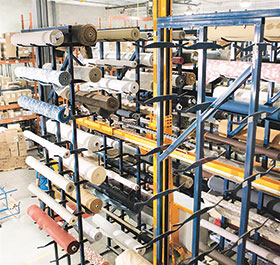

Short delivery times have become a decisive competitive requirement for consumer goods manufacturing. The consequence of that is that manufacturers have to fully optimise their production chains. One of the prerequisites for this is having a fully automated warehousing system. For example, where automatic conveying systems handle the storage and retrieval of fabrics in a furniture factory, not only manpower but also valuable warehouse space can be saved. Canadian solution provider Divel specialises in this market segment and develops fully automatic warehousing systems for the furniture industry.
The particular challenge facing furniture manufacturers today is the need to meet end customers’ individual wishes while at the same time maintaining profitability in production. Divel has developed a fully automatic fabric storage system for Canadel, a company founded in 1982 that manufactures home furniture from Canadian birch wood. The conveying system for material handling quickly and quietly zips between the extensive racks in which the furniture fabrics are stored. “High storage density, automated operation and minimal plant floor footprint were all key goals of Canadel,” says Louis Lupien, president at Divel. “Through the integration of leading-edge control technologies, and by leveraging our years of manufacturing experience, we struck a perfect balance in terms of performance and form factor.”
The warehousing system removes the fabric rolls, which can weigh up to 50 kg each, from the racks and takes them to the cutting machine, where the fabric is automatically cut to length for the respective order. It is subsequently trimmed exactly to size by a precision cutting machine and the fabric roll is then taken back to its location in the warehouse. The entire procedure is documented by an inventory management system.
PC Control platform reduces installation space
“A myriad of requirements had to be fulfilled when choosing the controller: these included reduced assembly and programming time, the integration of advanced programming methodologies, a variety of I/O signal types and reduced cabling requirements,” explains Jean-Sebastien Descôteaux, Divel operations director. For the automation of the fabric storage system, Divel selected a Beckhoff CP6202 Panel PC with a 38 cm touch screen on which the PLC, drive control and visualisation run. “The PC Control platform reduces the number of components and its compact size also decreases the required installation space,” Descôteaux emphasises. Apart from sequential control, the PC also handles data entry for the manual roll storage feed and withdrawal, alarm annunciation, sequence display, interface for manual operation and axis displacement, as well as inventory display and control.
TwinCAT software does not only automate the order in which rolls are put into storage. “With TwinCAT, we can also design dynamic graphical elements, such as on-screen push buttons, pilot lights, monitoring of actual values, recipe acquisition, data table displays, bar graphs and trends, among others. TwinCAT Modbus TCP Server is used to configure a communication path with the cutter for roll number orders and alarm advising. TwinCAT offers many advantages,” explains the Divel operations director. “The ability to use different programming languages represents a powerful advantage over other software options, since all programming challenges can be easily solved using the most suitable language for the task at hand. Built-in instructions and data conversion facilitate significant flexibility for data handling and management.”
Divel uses synchronous servomotors from the Beckhoff AM series and AX52xx EtherCAT Servo Drives in the motion system. “In the Canadel project, two axes of motion had to be used in master-slave mode, in order to create a linear movement with a rotary axis and another linear axis, due to tightness of space. The compact form factor of the Beckhoff components was a welcome addition to combat the space-constrained nature of the project,” comments Descôteaux.
Time and cost savings create competitive advantage
Divel has implemented the Beckhoff PC platform as a standard offering in its various product lines over the past seven years. “The use of EtherCAT as a universal bus system from the I/Os to the safety components to the motion system is a great advantage for us,” Lupien emphasises, and continues: “The speed of the communication system and its reliability are one aspect, but we also reduce costs through the use of EtherCAT. For instance, we were able to significantly reduce the cabling costs and the commissioning time through the use of standard Ethernet cables. The compact size of the PC-based control architecture also helped us reduce the electrical cabinet height by an impressive 15 cm, generating instant savings on each machine.”
Descôteaux also highlights the significant value found within EtherCAT connectivity and the feature-rich TwinCAT development environment: “The openness of the EtherCAT platform enables streamlined connectivity with the vast majority of popular fieldbuses as well as simple data collection for analysis of power quality and energy consumption. Data exchange with external databases is easy with the appropriate TwinCAT libraries, reducing programming time and effort.”
For more information contact Michelle Murphy, Beckhoff Automation, +27 (0)11 795 2898, [email protected], www.beckhoff.co.za
| Tel: | +27 11 795 2898 |
| Email: | [email protected] |
| www: | www.beckhoff.com |
| Articles: | More information and articles about Beckhoff Automation |

© Technews Publishing (Pty) Ltd | All Rights Reserved